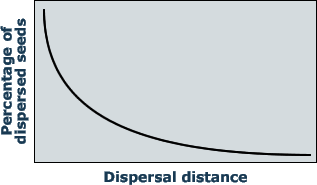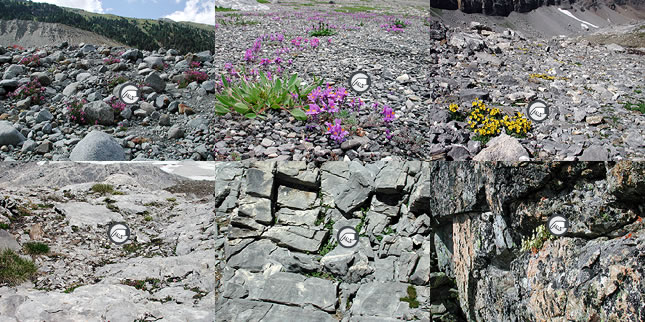 |
|
|
|
|
|
|
Seed dispersal Plants are sessile, but their genes move with seeds and pollen. Seeds capable to be dispersed over large distances are important for the colonization of new habitats. Most important are:
Most seeds are not dispersed far from the parent (see Table A). The dispersal curve for wind- or animal-dispersed seeds tend to be leptokurtic (Fig. 1). In habitats of high mountains seed dispersal by wind is most important, followed by running water in little streams or at the soil surface. Small seeds and wind-dispersal are the dominant characteristics of plants from early successional communities (glacier foreland, screes), larger seeds with lower dispersal capacities are more frequent in late successional communities (alpine meadows and shrub communities). |
1 - Typical leptokurtic seed dispersal spectrum with most seeds dispersed only over short distances (few decimetres to several metres) and few seeds dispersed over far distances (rare events, but ecologically important). 2 - Short distance dispersal of seeds in glacier foreland species |
|
Long distance dispersal by wind Wind dispersal spectra are regulated by two plant traits:
Using PAPPUS, a mechanistic wind dispersal model (Tackenberg 2003) it was demonstrated that because of more vertical turbulance and convective updrafts, alpine weather conditions are much more favorable for wind dispersal than conditions in the lowland. Seeds from alpine species with falling velocities up to ca. 1.5 ms-1 can be expected to be dispersed effectively by wind; whereas in the lowland falling velocities of ca. 0.5 ms-1 are already a threshold value for effective dispersal by wind (Tackenberg and Stöcklin 2008). Some of the seeds of the studied species were dispersed > 100 m, some reached distances > 1000 m. The species best dispersed by wind was Epilobium fleischeri, a pioneer of glacier foreland, with 5 % of the plumed seeds dispersed over distances > 1000 m. |
|
Examples of wind-dispersed species and their seeds 3 - Seeds of six characteristic species from a glacier forefield in the Swiss Alps. Weather conditions at high altitudes with frequent updrafts make that all these species are effectively dispersed by wind with a considerable percentage of seeds dispersed over more than 1000m. |
29 August 2011 |
||
| |
||


